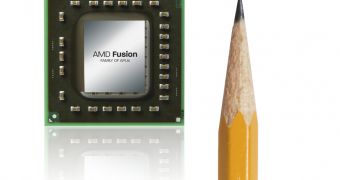AMD seems to be on a roll recently as after the company announced that it has started shipping the first Llano processors to its customers, the Sunnyvale-based company has now finished taping out the Wichita accelerated processing unit (APU), the successor of the current Ontario (AMD C-30 and C-50) chips.
Not so many details are available right now about Wichita, but we do know that AMD's upcoming APU will be built using the 28nm fabrication node, which should significantly reduce its power consumption.
In addition to the new manufacturing process, Wichita will also get one or two updated Bobcat cores and a faster on-die GPU which should feature similar performance to that of the current Zacate APUs.
An earlier roadmap released by AMD suggested that Wichita will launch together with the Krishna APU, which is also built using the same 28nm fabrication node, but it can feature up to four processing cores and is targeting faster systems, such as notebooks and nettops.
In electronics design, the “tape out” term is used to describe the final result of the design cycle of a chip and means that the integrated circuit can be sent to the foundry for manufacturing the first physical samples.
These will then go through a number of spins as the design is further refined to eliminate any potential flaws that made their way into the integrated circuit.
This is usually a pretty lengthy process, so the first batches of Wichita chips aren't expected to ship to OEMs earlier than Q4 2011 which could translate into a late 2011 or early 2012 launch (probably at CES).
The 28nm Wichita will be manufactured by Globalfoundries, which taped out the first ARM chips based on this fabrication node in September of 2010.
In addition to the new low-power Wichita and Krishna APUs, Globalfoundries will also manufacture for AMD the 28nm-based AMD Radeon HD 7000-series (code named Southern Islands) GPUs that taped out a short while ago. (via SemiAccurate)

 14 DAY TRIAL //
14 DAY TRIAL //